The Newspaper of Tomorrow: 11 Predictions from Yesteryear
eNewspapers were being developed as far back as the 1930s
![]()
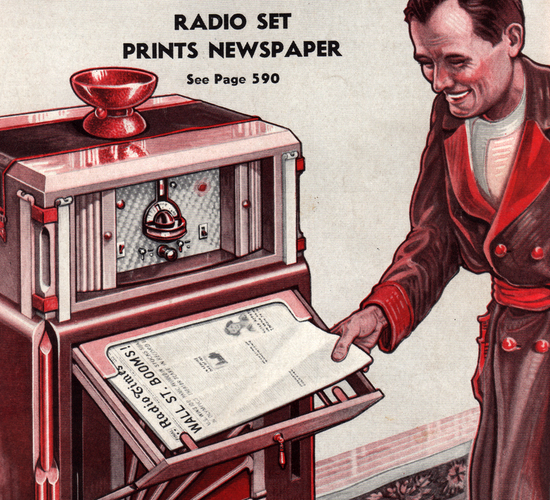
Newspapers printed by radio right in the home in 1934 (Source: Novak Archive)
Many of us here in the 21st century like to think of the newspaper as this static institution. We imagine that the newspaper was born many generations ago and until very recently, thrived without much competition. Of course this is wildly untrue. The role of the newspaper in any given community has always been in flux. And the form that the newspaper of the future would take has often been uncertain.
In the 1920s it was radio that was supposed to kill the newspaper. Then it was TV news. Then it was the Internet. The newspaper has evolved and adapted (remember when TV news killed the evening edition newspaper?) and will continue to evolve for many decades to come.
Visions of what newspapers might look like in the future have been varied throughout the 20th century. Sometimes they’ve taken the form of a piece of paper that you print at home, delivered via satellite or radio waves. Other times it’s a multimedia product that lives on your tablet or TV. Today we’re taking a look at just a few of the newspapers from the futures that never were.
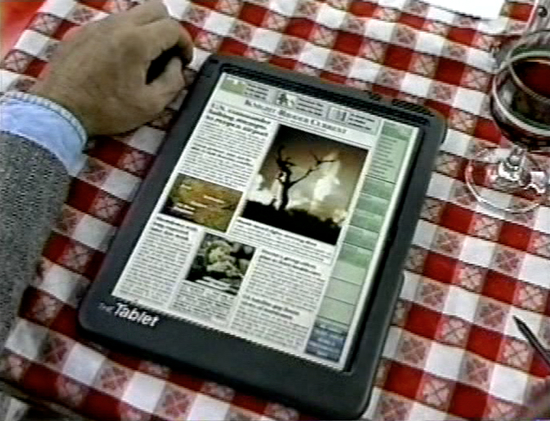
Tablet newspaper of the future from a 1994 Knight Ridder concept video
Knight Ridder’s Newspaper Tablet (1994)
The newspaper tablet of the future was demonstrated in a 1994 concept video released by Knight Ridder. I found the video over at the Open Video Project back in 2007 and wrote a short blog post about it. I’m sure glad I didn’t make any snarky comments about how this whole tablet thing was never going to happen because as we know, the iPad would emerge less than three years later.
Back in 2011, a judge in the Apple vs. Samsung patent battle made note of this video as possible prior art which could invalidate some of Apple’s iPad patents. However, last year an appeals court found that the Knight Ridder concept tablet couldn’t be considered prior art and that Apple’s patent claims were significantly different enough.
From the Knight Ridder video:
Let’s take a closer look at the Information Design Lab’s vision of the electronic newspaper of the future. On first glance, it looks just like a printed newspaper. In fact, you can browse stories and turn pages just as you would on paper. But if a story interests you, you can read it more deeply. Suppose this story about Bosnia catches your attention. Just touch the text and the full story appears. What you read is no longer limited to the physical constraints of the printing press and production process. A story is edited for content and completeness, not for newshole.
And the tablet newspaper extends communication beyond the written word. Touch the map and it comes alive, using the tools of sound and animation to tell the story.
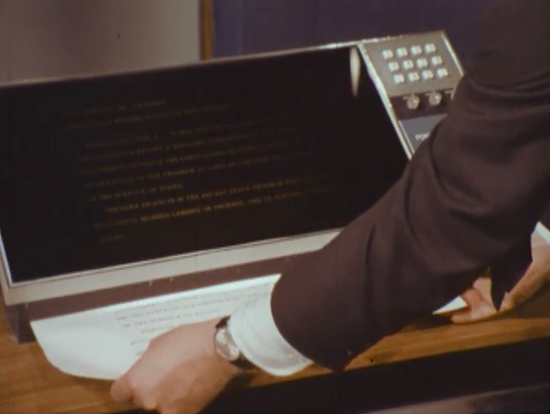
Philco-Ford’s newspaper printer of 2001 as demonstrated by Walter Cronkite (1967)
Philco-Ford’s Newspaper Printer (1967)
We recently looked at an episode of the CBS show “The 21st Century,” hosted by Walter Cronkite titled, “At Home, 2001.” Originally airing on March 12, 1967, the show took viewers of the late 1960s to the futuristic world of the year 2001. In the future, news would be delivered by a satellite feed and stories could be printed out at the touch of a button.
This console provides a summary of news relayed by satellite from all over the world. Now to get a newspaper copy for permanent reference I just turn this button, and out it comes. When I’ve finished catching up on the news I might check the latest weather. This same screen can give me the latest report on the stocks I might own.
You might recognize this newspaper printer from another concept video from 1967 by Philco-Ford called 1999 A.D.
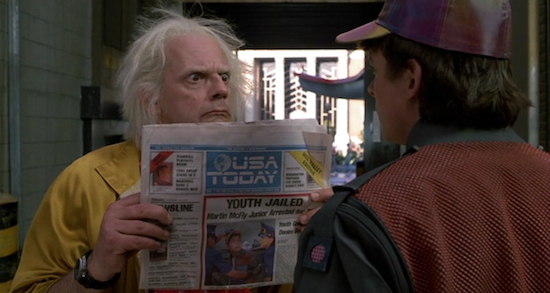
Doc holds a USA Today from the year 2015 in the film Back to the Future II (1989)
Back to the Future II (1989)
In Back to the Future II‘s futuristic world of 2015 they have hoverboards, flying cars and instant-dry jackets. But the newspaper’s physical presence looks pretty identical to that of 1989. The form and function hasn’t changed, but futurist jokes about everything unhealthy being good for you (think steak being healthy in Woody Allen’s Sleeper) is shown with this below the fold headline: “Cholesterol May Be Cancer Cure.”

Machine for printing a newspaper in the privacy of your own home via radio in 1938
RCA’s Newspapers by Radio (1930s, ’40s)
In the 1930s and ’40s a surprisingly large number of newspapers and broadcasters (sometimes owned by the same company) were experimenting with newspaper delivery by radiowaves. The idea was that unused radio spectrum could be licensed to deliver newspapers at night via “radio facsimile.” These “radio faxpapers” would be printed in the home while everyone was sleeping. The family would wake up to a freshly printed newspaper without a paperboy ever having to get his hands stained with ink.
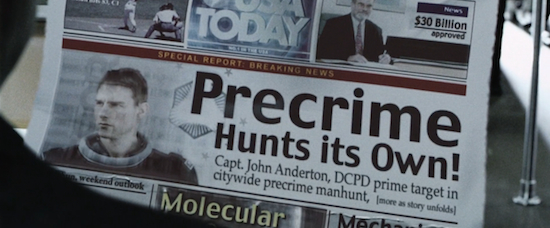
Digital newspaper of the year 2054 in the film Minority Report (2002)
Minority Report (2002)
The newspaper in the 2002 film Minority Report seems to have the size and flexibility of a printed newspaper, but the technological advancement of a web-connected device. Once John Anderton’s (Tom Cruise) becomes a fugitive of pre-crime justice we see a newspaper on public transit that’s interrupted with an animated breaking news special report.
My favorite headline from that newspaper is in the upper right corner of the screen: “$30 Billion approved.” For what, we’re not sure. But you can rest assured that $30 billion has been approved for something somewhere.

Partial cover of the April 3, 1988 Los Angeles Times magazine
L.A. Times Laserjet Printed Newspaper (1988)
The April 3, 1988 issue of the Los Angeles Times Magazine was dedicated to what Los Angeles might look like in the year 2013. Their predictions included art by Syd Mead and plenty of what you’d expect from late-1980s futurism: fingerprint verification at the ATM, computers in the classroom, smart appliances, and plenty of household robots. The prediction about what the newspaper of the future might look like included printed copy delivered electronically to you by way of the personal computer:
With a barely perceptible click, the Morrow house turns itself on, as it has every morning since the family had it retrofitted with the Smart House system of wiring five years ago. Within seconds, warm air whooshes out of heating ducts in the three bedrooms, while the water heater checks to make sure there’s plenty of hot water. In the kitchen, the coffee maker begins dripping at the same time the oven switches itself on to bake a fresh batch of cinnamon rolls. Next door in the study, the family’s personalized home newspaper, featuring articles on the subjects that interest them, such as financial news and stories about their community, is being printed by laser-jet printer off the home computer — all while the family sleeps.

George Jetson reading the newspaper on his Televiewer (1962)
Jetson’s Televiewer (1962)
In the third episode of “The Jetsons” George sits down to read the newspaper on his Televiewer device. As we’ve seen with videophones in the Jetsons universe, there’s not a lot of consistency around what the various devices are capable of doing. Sometimes a given console will appear to be dedicated to one task (as is often the case with their videophones) but here George appears to be reading on a more generic device that we can assume might also handle broadcast TV.
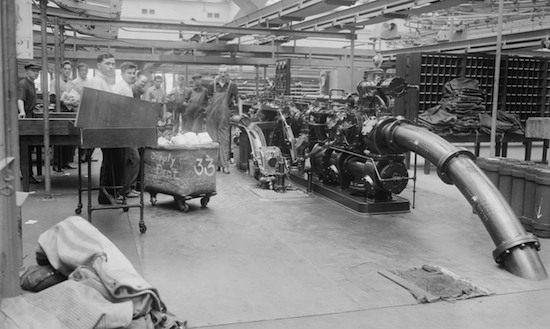
New York post office with pneumatic tube circa 1914 (Source: Library of Congress)
Pneumatic Tube Delivery (1900)
As we’ve seen in our examination of the midcentury animated TV show “The Jetsons,” the pneumatic tube was thought to be the wave of the future, being installed as a way to deliver goods (and people!) right into our homes. The newspaper may still be of the deadtree variety, but according to the December 24, 1900 issue of the Boston Globe Bostonians of the future would have their paper delivered each morning by tube.
The pneumatic tube service, by the way, will have reached its perfection long before the first half of the new century has flown. It will have become a most important factor in the domestic life of the people which also will have undergone great changes.
Through such tubes a householder will undoubtedly receive his letters, his readymade lunches, his laundry, his morning and evening paper, and even the things he may require from the department store, which will furnish at the touch of a button any essential solid or liquid that can be named.
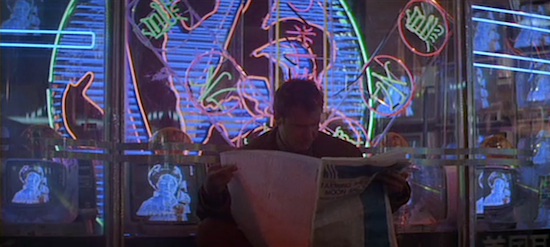
Rick Deckard reads a newspaper in the year 2019 in Blade Runner (1982)
Blade Runner (1982)
In the 1982 neo-noir film Blade Runner directed by Ridley Scott, we see the protagonist Rick Deckard (Harrison Ford) reading a newspaper. The film takes place in the year 2019, but the newspaper looks like it would be right at home in 1982. That is, except for the content. The newspaper headline is difficult to make out, but according to Blade Runner messageboards the headline probably reads: “Farming the Oceans, the Moon, and Antarctica.”
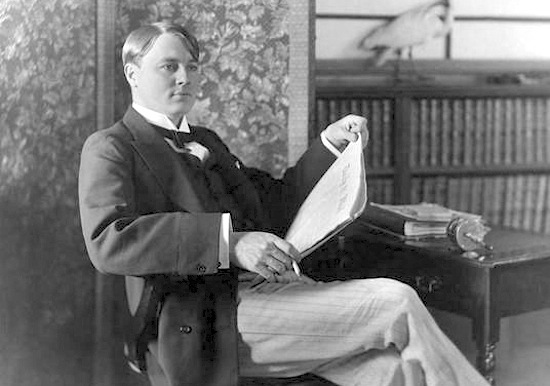
Alfred Harmsworth in 1896 (Source: National Portrait Gallery, London)
National Newspaper (1900)
At the turn of the 20th century, newspapers were incredibly local. There was no such thing as a nationally focused newspaper like USA Today. But in the December 26, 1900 issue of the New York World, Alfred Harmsworth, the editor of the London Daily Mail, predicted that there would soon be national newspapers.
We are entering the century of combination and centralization. I feel certain that the newspaper of the twentieth century will be drawn into the vortex of combination and centralization. In fact, given the man, the capital, the organization and the occasion, there seems to be no reason why one or two newspapers may not presently dominate great sections of the United States, or almost the whole of Great Britain. In other words, where there are now a multitude of papers — good, bad and indifferent — there will be then one or two great journals.

A newsboy from Philadelphia wears a neon sign to sell his papers in 1937 (Source: Novak Archive)
Neon Newsboy (1937)
Today the street corner newsboy may be relegated to cartoon cliches about young newsies screaming “EXTRA! EXTRA!” all around town to announce breaking news, but back in 1937 newsboys in Philadelphia were outfitted with the wave of the future: neon signs. From the April, 1937 issue of Popular Mechanics magazine:
Newsboys in Philadelphia wear neon signs that flash across their chests the name of the paper they represent. The neon lamp not only has a strong advertising appeal, making it easy to “spot” a newsboy on a crowded street at night, but it protects the boy selling paper in automobile traffic. To be practical, the chest lamp had to be shockproof and operate on a portable battery. The name of the newspaper is made of a single continuous tube of glass, its base imbedded in a plastic substance which protects the tube from shock and breakage. The neon is activated by a battery which gives forty-eight hours service on one cell. A small vibrator changes the direct current to alternating current and a transformer steps up its voltage. Battery, vibrator and transformer are carried in the boy’s apron.
/https://tf-cmsv2-smithsonianmag-media.s3.amazonaws.com/accounts/headshot/matt-novak-240.jpg)
/https://tf-cmsv2-smithsonianmag-media.s3.amazonaws.com/accounts/headshot/matt-novak-240.jpg)